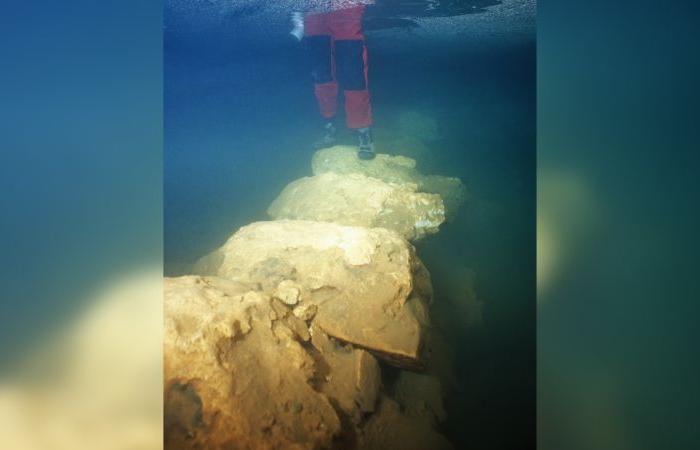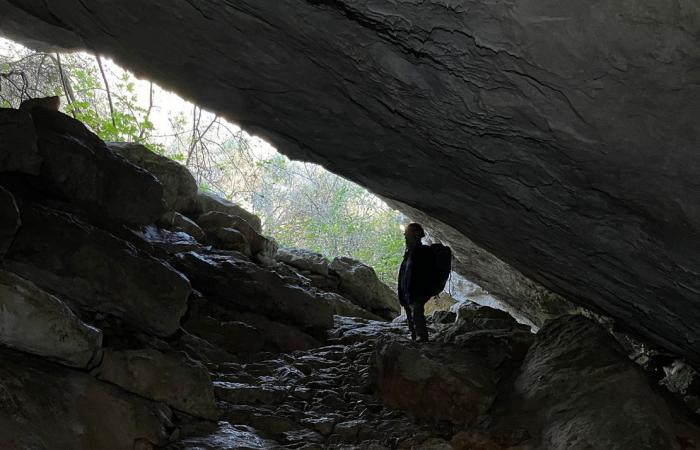Sign up for CNN’s Wonder Theory science newsletter. Explore the universe with news on fascinating discoveries, scientific advancements and more
CNN
—
An ancient, submerged bridge in a cave on the Spanish island of Mallorca is helping researchers determine when humans first settled on islands across the western Mediterranean Sea thousands of years ago.
A new analysis of the 25-foot-long (7.6-meter-long) bridge inside Genovesa Cave has revealed that humans lived on Mallorca, one of the largest islands in the Mediterranean, much earlier than previously believed. The findings could narrow the gap between when humans settled in the eastern and western Mediterranean regions.
A study detailing the findings published Friday in the journal Communications Earth & Environment.
A lack of written records and limited archaeological evidence have made it difficult to piece together the point at which humans colonized and settled on the Mediterranean islands.
But a telltale “bathtub ring,” along with mineral formations detected on the bridge, has allowed scientists to estimate that the structure was built nearly 6,000 years ago, said lead study author Bogdan Onac, a professor in the School of Geosciences at the University of South Florida.
“The presence of this submerged bridge and other artifacts indicates a sophisticated level of activity, implying that early settlers recognized the cave’s water resources and strategically built infrastructure to navigate it,” Onac said.
The bridge is made of large, heavy limestone blocks, some of which span 4.2 feet (1.3 meters) across, and it remains unclear what mechanisms enabled ancient humans to build the bridge.
Researchers believe that those who built the bridge wanted a dry, continuous path to connect the cave’s entrance with a chamber beyond a lake within the cave.
The cave’s bridge was first discovered in 2000. A few years afterward, a study written in the Catalan language estimated the bridge to be 3,500 years old based on pottery found in one of the cave’s chambers.
Since then, research that radiocarbon-dated bones and pottery on Mallorca suggested a human presence may have been on the island 9,000 years ago, but poor preservation of the materials led researchers to question that timeline.
More recent research studying ash, bones and charcoal on the island suggests humans settled there about 4,440 years ago.
But having studied the rise of sea levels across other islands and the geologic footprints that sea level rise can leave behind, Onac and his colleagues took a different approach.
“It was only in the past four years that we finally gathered the data needed to address this longstanding research topic and better estimate the arrival time of humans in Mallorca,” Onac said.
Today, Genovesa Cave’s passages remain flooded as global sea levels rise.
Onac and his colleagues studied a light-colored band on the submerged bridge within the cave as well as calcite encrustations that formed on the bridge during times when the sea level was higher and filled the cave.
The encrustations are speleothems, or geologic formations that result from mineral deposits accumulating over time in caves.
By reconstructing historic local sea levels and analyzing the coloration band on the bridge as well as the mineral deposits, the team determined that the bridge was assembled about 6,000 years ago.
The color band matched the same level where mineral deposits formed when the sea level was at a standstill, indicating it must have been constructed earlier than 5,600 years ago, Onac said.
The bridge was likely used for 400 to 500 years before rising sea levels caused the cave’s lake to cover the bridge, Onac said.
The team doesn’t have clear evidence on how ancient humans used the cave, but it has some scenarios in mind.
Cave divers have found fossil remains from a now-extinct goat species that once lived on the island known as Myotragus balearicus. They also discovered pottery within a drive chamber connected to the cave entrance by the bridge, Onac said.
“This suggests that humans may have used the area near the cave entrance, a large collapse chamber, for living,” Onac said. “The purpose of crossing the lake to access that chamber remains unclear; it could have served as a refuge, place for rituals, or as a storage place, keeping food out of Mallorca’s hot days.”
There is evidence of small stone homes and structures made from large stones in Mallorca between 2,000 to 4,500 years ago. So it’s likely that the cave bridge is a precursor to the larger, more sophisticated stone works found on the island, Onac said.
Paleontologists are still trying to determine why Mallorca was settled later than the eastern Mediterranean Islands. Although it’s large and fairly close to Spain’s mainland, the island had a hot, dry climate with thin soil for farming. And apart from fish and native goats, Mallorca lacked a bevy of natural resources.
“In contrast, other islands had more favorable environmental conditions and abundant resources, such as minerals and livestock, which made them more attractive for early settlers,” Onac said.







